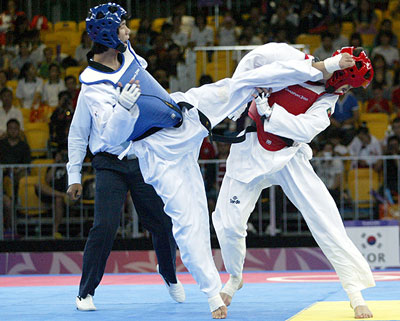 TaeKwonDo - Korea: "The way of the hand and foot" - a modern martial art from Korea that is characterised by its fast, high and spinning kicks. It combines combat techniques, self-defense, sport, exercise, and in some cases meditation and philosophy. In 1989, Taekwondo was the world's most popular martial art in terms of number of practitioners. Gyeorugi, a type of sparring, has been an Olympic event since 2000.
TaeKwonDo - Korea: "The way of the hand and foot" - a modern martial art from Korea that is characterised by its fast, high and spinning kicks. It combines combat techniques, self-defense, sport, exercise, and in some cases meditation and philosophy. In 1989, Taekwondo was the world's most popular martial art in terms of number of practitioners. Gyeorugi, a type of sparring, has been an Olympic event since 2000.
There are two main branches of taekwondo development, which are not necessarily mutually exclusive:
"Traditional taekwondo" typically refers to the martial art as it was established in the 1950s and 1960s in the South Korean military, and in various civilian organisations, including schools and universities. In particular, the names and symbolism of the traditional patterns often refer to elements of Korean history, culture and religious philosophy. Today, the Kukkiwon, or World Taekwondo Headquarters is the traditional center for Taekwondo in Korea.
"Sport taekwondo" has developed in the decades since the 1950s and may have a somewhat different focus, especially in terms of its emphasis on speed and competition (as in Olympic sparring). Sport taekwondo is in turn subdivided into two main styles; one derives from Kukkiwon, the source of the sparring system sihap gyeorugi which is now an event at the summer Olympic Games and which is governed by the World Taekwondo Federation (WTF). The other comes from the International Taekwon-Do Federation (ITF).
A brief time table showing the recent progress of TaeKwonDo:
1945 - Korea was liberated from the Japanese and Koreans began returning to traditional Korean martial arts
1955 - Various Kwan masters officially named their art TaeKwonDo
1965 - The Korea Taekwondo Association was formed.
1973 - World TaeKwonDo Federation created.
1975 - General Association of International Sports Federations recognizes the WTF.
1976 - TaeKwonDo accepted as a Consul International du Sport Militaire sport (world level military sports organization).
1980 - International Olympic Committee recognizes the WTF.
1981 - TaeKwonDo accepted as a World Games sport
1983 - TaeKwonDo accepted as a Pan American Games and All Africa Games sport
1985 - TaeKwonDo adopted as a demonstration sport for the 1988 Olympic Games.
1986 - TaeKwonDo accepted as a Federation International du Sport Universitaire sport (world university level sport organization).
1988 - TaeKwonDo is an Olympic demonstration sport in Seoul, South Korea
1992 - TaeKwonDo is an Olympic demonstration sport in Barcelona, Spain.
1994 - TaeKwonDo selected as a full Olympic sport for the 2000 Olympic Games in Sydney, Australia.
1996 - TaeKwonDo is an Olympic demonstration sport in Atlanta.
2000 - TaeKwonDo officially an Olympic sport Sydney Australia
2004 - TaeKwonDo official Olympic sport - Athens
2008 - TaeKwonDo official Olympic sport - Beijing
2012 - TaeKwonDo official Olympic sport - London
Some videos for Olympic TaeKwonDo competitions
|
Below is a video about TaeKwonDo from The History Channel TV Series Human Weapon
|
|
Please refer to our references as we have used a few different sources for the basic explanation of each martial art discipline. Many of our direct links, images and text will be from the site Wikipedia which is not known for the most accurate information when it comes to doing a thesis or studying for ones P.H.D. but does have a large collection of data that is well organized. Much of the text regarding martial arts styles on Wikipedia seems to generally sum up each discipline as good as many other sources. We do not intend to re-invent the wheel, but we do want to roll you in a good direction in order to get a glimps of each style.
| References: | http://www.usgyms.net | |
| http://en.wikipedia.org | ||
| http://www.thelawofthefist.com | ||

